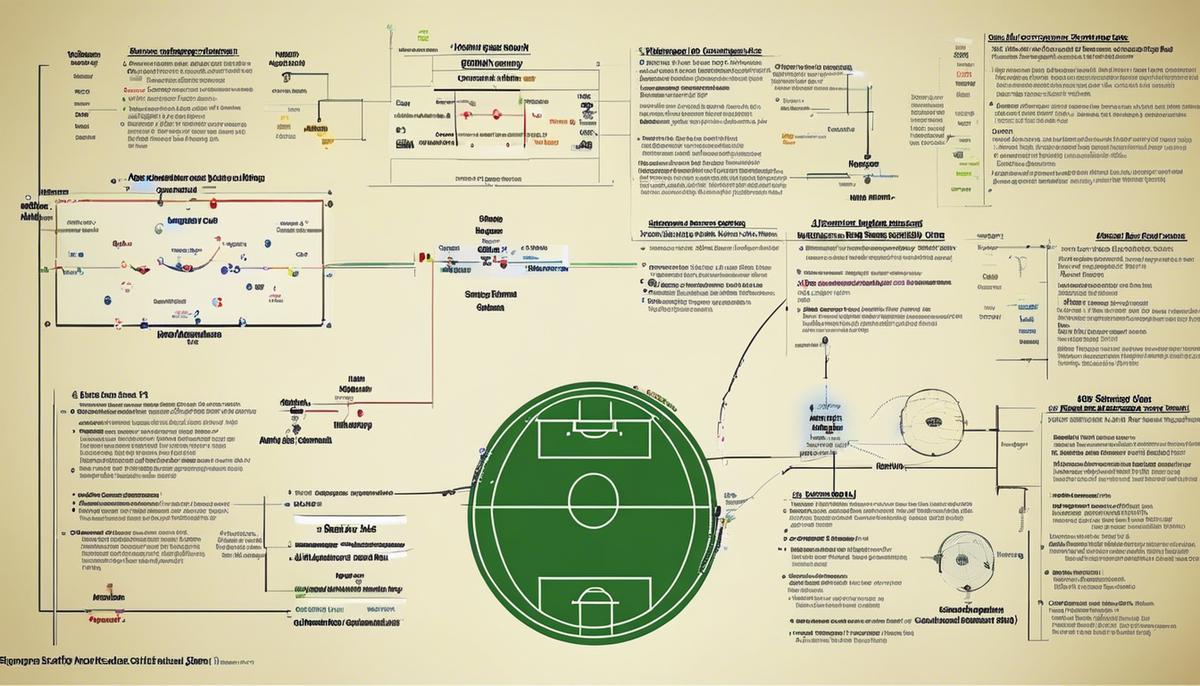In the intricate chess match that is American football, defense serves as the formidable bulwark poised to repel the onslaught of the opposing team’s offense. The strategic deployment of various defensive formations is crucial to a team’s success, as they must respond to ever-evolving offensive schemes. This essay delves into the complexities of football defenses, starting with an in-depth exploration of standard formations such as the 4-3, 3-4, and nickel packages. It elucidates the dynamic roles of linebackers, linemen, and secondary players, laying the groundwork for understanding how these units synchronize to disrupt and ultimately stifle their adversaries.
Understanding Defensive Formations
Defensive Formations in Football
In football, defensive formations are the alignments and strategies that the defense employs to counteract the offense’s game plan. Key commonly used defensive formations include the 4-3, 3-4, and nickel formations.
4-3 Formation
The 4-3 formation consists of four defensive linemen and three linebackers. This formation focuses on versatility and is particularly effective against the run. The defensive line has two tackles and two ends, with the primary responsibility of disrupting the backfield and containing the run. The linebackers, usually a combination of middle and outside, are responsible for coverage and run support. They also act as a buffer to protect the secondary from direct attack.
3-4 Formation
The 3-4 formation, on the other hand, features three defensive linemen and four linebackers. The linemen are responsible for occupying offensive blockers, allowing the linebackers more freedom to make plays. The versatility of this formation lies in the unpredictability of the linebackers’ roles who may rush the quarterback, cover receivers, or defend against the run based on the specific play call.
Nickel Formation
The nickel formation is a more pass-oriented defensive alignment that brings an extra defensive back, usually a fifth cornerback or a nickelback, onto the field in place of a linebacker. This formation provides better pass coverage due to the additional defensive back and is typically employed in obvious passing situations or against teams that use multiple wide receiver sets.
Roles and Responsibilities
Defensive Line
The defensive line, consisting of tackles and ends, is the first line of defense. Their main task is to break through the offensive line to tackle the quarterback or ball carriers and to disrupt the offensive plays.
Linebackers
Linebackers play behind the defensive line and are known for their versatility. They shift between coverage assignments, managing threats from tight ends and running backs, and rushing the quarterback. Linebackers need to react quickly to the unfolding play, whether it is penetrating the backfield, containing outside runs, or supporting the secondary in pass coverage.
Secondary
The secondary, comprising cornerbacks and safeties, is responsible for defending against the opposing team’s passing attack. They cover receivers, defend space in the zone, and also provide run support. Safeties generally have dual roles – free safeties are the last line of defense and strong safeties often have a more active presence near the line of scrimmage.
Adapting Defensive Formations to Offensive Schemes
Defensive units must continually adjust their formations in response to the offensive playbook, tackling strategies like the hurry-up offense, play-action passes, and mobile quarterback tactics. Coaches orchestrate these adjustments by signaling different defensive plays, shifting formations, or making strategic personnel changes to counter the offense’s approach effectively. Communication between defensive players is vital to ensure these changes are implemented quickly and seamlessly. Recognizing opponent formations, understanding common tendencies, and predicting plays are essential skills for a defense to respond adeptly and work together coherently.
Defensive strategies are often dynamic and reactive, with audibles and shifts determined just before the snap. The defensive team has to accurately read the offensive alignment and decide rapidly to sustain their edge in the game. Their playbook includes a diverse range of tactics, from blitzes to variations of zone or man-to-man coverage, chosen based on situational factors like the down, distance, and offensive play trends.
In essence, the intricacy of defensive gameplay in football stems from the ongoing chess match with offensive platoons. A keen understanding of the capabilities and tactical use of various defensive formations equips teams with the tools needed to thwart different offensive strategies they encounter on the gridiron.

Implementing Defensive Plays and Tactics
Implementing Blitzes Strategically
The blitz represents a bold defensive approach where extra players, typically linebackers or defensive backs, aggressively pursue the quarterback to interrupt the play’s rhythm. The aim is to either tackle the quarterback for a loss of yards or compel a rushed throw, increasing the chance of an interception or incompletion. The success of a blitz hinges on the element of surprise and proper timing, requiring blitzer to mask their intentions until the last possible moment, keeping the offense off-balance.
A blitz can vary in complexity, from the number of defenders involved to the overarching defensive context. For example, a ‘zone blitz’ cleverly sends one player—often a lineman—into pass coverage, taking over for a linebacker who rushes the quarterback. This maneuver can befuddle the offensive line and signal-caller, creating opportunities for defensive success. However, effective blitzing demands that all on defense maintain rigorous discipline to close off potential routes that the offense might exploit if given the chance.
Stunts in Defensive Line Play
Stunts, or “twists,” are planned movements by defensive linemen to confuse or breach the offensive line. They usually involve two or more linemen switching their attack points or lanes after the snap. For example, a ‘tackle-end exchange’ (TEX) stunt has the defensive tackle attack the outside gap while the defensive end moves inside, often navigating around the tackle. This can catch the offensive line off guard, creating opportunities for sacks or disruption in the backfield. Timing and chemistry are imperative; a poorly executed stunt can leave large running lanes for the offense.
Man-to-Man vs. Zone Coverage
Defensive strategies in football revolve significantly around pass coverage, predominantly man-to-man or zone coverage. In man-to-man, defenders are tasked with shadowing specific offensive players anywhere they go after the snap, aiming to prevent them from catching the ball. This coverage is advantageous for disrupting timing routes but can be vulnerable to high-speed receivers or complex offensive schemes that use a lot of motion and picks.
Zone coverage, on the other hand, has defenders responsible for guarding specific areas of the field rather than tracking individual offensive players. Successfully conducting zone defense demands solid communication and the ability to read the quarterback’s eyes and react to the ball, making it effective against quarterbacks who are less accurate or tend to telegraph their throws. Zone defenses can adapt to various situations by implementing different zone schemes such as Cover 2, Cover 3, or Cover 4, each distributing the deep and short field responsibilities differently among the defensive backs and linebackers.
Recognizing and Responding to Offensive Alignments
A key component of defensive strategy is the ability to recognize and respond to different offensive alignments, such as single-back, I-formation, or shotgun, and their associated tendencies. Defensive players and coaches study film to understand opponent tendencies—like which formations lead to run plays and which to pass plays. Realigning the defensive formation in response, such as shifting towards or away from the strength of the offensive formation (the side with more players), helps counteract the offense’s plan. Being adept at recognizing formations on-the-fly allows a defense to adjust their coverages, blitzes, and gap assignments to match up more effectively against the offense.
In-Game Adjustments and the Defensive Coordinator’s Role
In-game adjustments are pivotal for the success of a defense in football. When offensive strategies begin to pinpoint and leverage weaknesses, it’s the adept defensive coordinator who must dynamically tweak the game plan accordingly. Such adjustments might entail shifting from man coverage to zone defense or increasing the blitz frequency to pressure a quarterback who’s otherwise too comfortable in the pocket. These defensive plays are counter-measures to the offensive team’s maneuvers, and it’s the defensive coordinator’s job to foresee and counteract these offensive shifts, essentially partaking in a strategic battle akin to chess, unraveled in real time. The fruits of pre-game strategic layouts and in-the-moment decisions visible on the field critically influence a defense line’s performance.
For a defense to successfully pivot during a game, communication is key. Strategic changes are communicated via timeouts, shifts in possession, or even swift exchanges on the sidelines. It’s here that player flexibility and their in-depth grasp of the game become invaluable. The intricacies tied to on-the-fly strategic shifts demand that each player grasps their role and its impact on the defense’s collective effort.

Player Training and Skills Development
Defensive Training in Football
Becoming adept on defense demands a rigorous and focused training regimen meant to sharpen the players’ individual skills, relevant to their roles, while building a holistic understanding of the defense strategy. This includes perfecting tackling techniques, learning effective pass-rush maneuvers, and mastering various coverage skills. Training is multifaceted and customized but unifies towards a single purpose: a seamless and powerful defense that can confidently adjust to any in-game scenario.
Tackling Technique
Proper tackling is fundamental to a stout defense. Coaches emphasize the importance of safe and effective tackling that avoids penalties and reduces the risk of injury. Players practice various techniques, such as form tackling, where they learn to keep their head up, wrap their arms securely around the opponent, and drive through the tackle with their legs. Players often engage in drills that reinforce muscle memory for these movements ensuring they become second nature during a game.
Pass Rush Moves
Pass rushers, typically defensive linemen and linebackers, are trained in a variety of techniques to get past offensive blockers and pressure the quarterback. These techniques include swim moves, spin moves, bull rushes, and rip moves. Each player must develop a repertoire of moves, as versatility is crucial in outwitting offensive linemen who will try to counter the pass rusher’s tactics. Drills that increase agility, strength, and quickness are key elements of training for pass rushers.
Coverage Skills
Defensive backs, such as cornerbacks and safeties, spend significant time developing their coverage skills. This includes understanding how to read receivers and quarterbacks, proper footwork, and mastering techniques like bump-and-run and zone coverage. They engage in drills that improve their hip flexibility, speed, and ability to change direction quickly, which is vital when tracking the ball and maintaining coverage on fast-moving receivers.
Team Chemistry and Communication
Beyond the individual skills, defensive players are trained to function cohesively as a unit. Communication before the snap and during the play is crucial in football defense, as players need to quickly identify and respond to the offensive set. Hand signals, verbal cues, and pre-determined adjustments are practiced repeatedly.
Game Tape Analysis
An often overlooked but critical aspect of defensive training is studying game tape. Players and coaches review footage of both their team’s past performances and upcoming opponents to understand tendencies, identify weaknesses, and develop game plans. Knowledge gleaned from these sessions informs the strategy for individual players and the defense as a whole.
Physical Conditioning
Finally, defensive players undergo intensive physical conditioning to build the strength, stamina, and durability necessary to withstand the rigors of their roles. Position-specific training is coupled with overall conditioning, which includes cardiovascular workouts, weight training, and flexibility exercises.
Every football player, from the youth leagues to the pros, invests immeasurable hours in honing their defensive abilities. Mastery on defense often proves critical in building teams capable of competing for championships, and it requires continuous improvement to counter the wide array of offensive strategies they might encounter.

Analyzing Game Film and Opponent Tendencies
Significance of Studying Game Film in Football
Part of this defensive mastery comes from the meticulous analysis of game film, an invaluable practice for players and coaches alike. Through examining recordings of opposing teams, they unravel the nuances of an adversary’s play-calling, detect patterns among players, and note how individuals handle specific game-time pressures. For example, a defensive back may decipher a wide receiver’s patterns to predict and intercept passes, potentially changing the game’s momentum.
Dissecting game footage also reveals weak spots such as a lineman’s trouble with certain defensive maneuvers or a quarterback’s decreased accuracy on the move. This intelligence enables defensive coordinators to craft strategies that capitalize on these deficiencies, possibly ordering a blitz package or coverage adjustment to enhance their team’s performance defensively.
Moreover, the knowledge of an opponent’s favored plays in certain scenarios is invaluable. If analysis shows an inclination for running right in tight-yardage situations, the defensive play-caller might realign his players to counteract this trend, thereby improving the defense’s effectiveness. Strategic foresight based on game film analysis remains a key factor in dictating defensive formations and play selection.
Evolution of Scouting and Data Analysis
The evolution of scouting and data analysis has considerably enhanced the process of preparing for an opponent. In the past, scouting relied heavily on in-person observation and note-taking. Today, sophisticated software allows for intricate breakdowns of game footage, where data can be sorted by down, distance, formation, and a multitude of other variables, offering a multifaceted view of opponents’ habits and strategies.
Advanced metrics, such as quarterback pressures versus actual sacks or the success rate of certain plays against specific defensive formations, are used to evaluate both the opponent and a team’s own effectiveness. Data analysis has also led to personalized matchup scouting, highlighting how well individual players perform against specific opponents, enabling coaches to make informed decisions on match-ups and playing time.
Teams use scouting reports and data not just to prepare for the next opponent, but to develop overarching strategies, scouting potential free-agent signings or upcoming draft picks to bolster weak areas identified during film review and statistical analysis.
Developing Game-Specific Strategies
With insights gathered from film study and data analytics, coaches devise game-specific strategies that cater to their team’s strengths and the opponent’s identified weaknesses. Strategies may encompass a wide range of tactics, from defensive line stunts designed to pressure an inexperienced quarterback, to zone blitzes that confuse offensive linings, to secondary coverages that bait quarterbacks into throwing into disguised traps.
Linebacker alignments, pre-snap adjustments, and even the way safeties communicate on the field can be tailored to counteract specific offenses. For example, if an offense excels at quick passes, defenders might play closer to the line of scrimmage to disrupt timing routes. Conversely, against a deep-throwing offense, a defensive coordinator might implement more deep safety help and press corners to allow the pass rush more time to pressure the quarterback.
Ultimately, the combination of film study, scouting, and data analysis equips a football team with a deeper understanding of their upcoming opponent, facilitating a detailed approach to defensive play-calling and execution that is paramount for on-field success. As technologies and data analytics continue to evolve, so too will the intricacy and effectiveness of defensive strategies in football.

The tapestry of football is interwoven with the relentless pursuit of strategic mastery, and at the heart of this pursuit is the art of defense. Mastery over this art comes from meticulous preparation, rigorous training, and insightful analysis of opponents. While the grandstands may erupt for the spectacle of offensive triumph, it is the shrewd, anticipatory nature of a well-crafted defense that truly anchors a team’s success. Through the thoughtful synthesis of formations, tactics, player development, and strategic analysis, the essence of a formidable defense is one that can pivot and adapt, demanding perpetual innovation and resilience on the gridiron.




